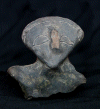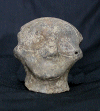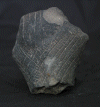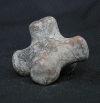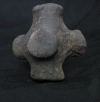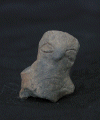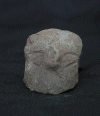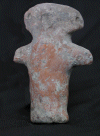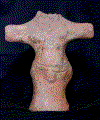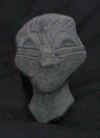Vinča culture
From Wikipedia, the free encyclopedia
(Redirected from Vinca culture)
The Vinča culture was an early culture of Europe (between the 6th and the 3rd millennium BC), stretching around the course of Danube in Serbia, Romania, Bulgaria, and the Republic of Macedonia, although traces of it can be found all around the Balkans, parts of Central Europe and Asia Minor.
Contents[hide] |
|
|
|
[edit] Discovery
The Vinča Culture derives its name from the village of Vinča, located on the banks of Danube, 14 km downstream from Belgrade (at the 1145th nautical kilometer), where one of the largest and most significant prehistoric Neolithic settlements in Eastern Europe was discovered in 1908 by a archaeological excavation team led by Miloje M. Vasić, the first schooled archeologist in Serbia.
Owing to Vasić's enormous energy and efforts, the central and at the same time most important part of prehistoric Vinča was excavated between 1918 and 1934. Interrupted by wars and financial troubles, but also aided by the Archeological Institute of Imperial Russia, as well by the British patron Sir Charles Hyde, Vasić excavated a large collection of prehistoric objects of art which are located today in the collections of museums and universitites throughout the world. The excavation was visited by numerous prominent scholars of the time: Veselin Čajkanović, Charles Hyde, J. L. Myres, W. A. Hurtley, Bogdan Popović and Gordon Childe.
At that time it was believed by both Yugoslav and Romanian archaeologists that the Vinča culture began around 2700BC. However carbon dating pushed the date of the civilization back to before 4000 BC cal.
In the sixth millennium B.C., the Vinča culture covered the area of the Central Balkans which is bordered by the Carpathian Mountains in the north, by Bosnia in the west, by the Sofia Plain in the east and the Skoplje Valley in the south.
[edit] Architecture
In the older Starčevo settlement, located in the deepest layers of Vinča, mud huts with tent roofs were discovered in which the settlers of the Starčevo-culture lived and were also buried. During the period of the Vinča Culture, houses were erected above ground with complex architectural layouts and several rooms, built of wood that was covered in mud. The houses in the settlement are facing northeast - southwest, with streets between them. Other settlements include Divostin, Potporanj, Selevac, Pločnik, Predionica Liobcova and Ujvar.
[edit] Economy
Beside agriculture and the breeding of domestic animals, the Neolithic settlers of Vinča also went hunting and fishing. The most frequent domestic animals were cattle, although smaller goats, sheep and pigs were also bred. The settlers of Vinča cultivated grain(einkorn and emmer, some barley). A surplus of products led to the development of trade with neighboring regions which supplied salt, obsidian, or ornamental shells (spondylus). The local production of ceramics reached a high artistic and technological level. Objects fashioned out of bones, horns and stone indicate great skill and dexterity of the craftsmen who produced tools for all branches of Vinča economy. At Bele Vode and Rudna Glava in Eastern Serbia copper ore was mined which they began fashioning with fire, initially only for ornamental objects (beads and bracelets).
[edit] Spiritual life
The Neolithic settlers of Vinča ascribed great importance to spiritual life as is reflected by the enormous number of cult objects (figurines, sacrifical dishes, anthropomorphic and zoomorphic dishes). Their artistic and stylistic development was conditioned by the teachings of old settlers, as well as by contacts with neighboring peoples and their beliefs. Anthropomorphic figurines have a characteristic dignified stance and their number (over 1000 examples at Vinča alone) exceeds the total number of figurines discovered in the Greek Aegean. Shrines were discovered in Parṭa Transylvania with complex architectural designs. Some figurines and ceramic dishes discovered in the broad region spanning from Gornja Tuzla to Tǎrtǎria bear signs which some scholars suppose to be primitive forms of writing (see Old European Script). Indeed, if the inscriptions on the Tartaria tablets are pictograms, as Vlassa argued, they would be the earliest known writing in the world. This claim however remains controversial; most experts consider the Tartaria finds to be an example of proto-writing rather than a full writing system.
[edit] Decline
During the middle of the fourth millennium, the entire region of the Vinča Culture underwent stagnation, followed by deep crises and a decline in cultural and economic development.
[edit] See also
- Old European script (Sometimes called "the Vinča alphabet".)
- Tartaria tablets
- Neolithic Europe
- Cucuteni culture
- Yamna
- Prehistoric Romania
[edit] Bibliography
Gimbutas, Marija A. (ed.) "Neolithic Macedonia as reflected by excavation at Anza, southeast Yugoslavia." Los Angeles: Institute of Archaeology, University of California, 1976. OCLC# 3073058
[edit] External links
- Vinca culture pottery
- culture.fr: The Vinca Culture
- Vinca, Centre of the Neolithic culture of the Danubian region
- The Vinca Alphabet, as a Windows TTF font
- The Neolithic Settlement of the Balkans
Old European Script
From Wikipedia, the free encyclopedia
(Redirected from Old European script)The Old European Script (also known as the Vinča alphabet, Vinča script or Vinča-Turdaş script) is a name sometimes given to the markings on prehistoric artifacts found in south-eastern Europe. Some believe the markings to be a writing system of the Vinča culture, which inhabited the region around 6000-4000 BC. Others doubt that the markings represent writing at all, citing the brevity of the purported inscriptions and the dearth of repeated symbols in the purported script.
Contents
[hide][edit] The discovery of the script
In 1875, archaeological excavations led by the archeologist Zsófia Torma (1840–1899) at Turdaş (Tordos), near Orăştie in Transylvania (now Romania) unearthed a cache of objects inscribed with previously unknown symbols. A similar cache was found during excavations conducted in 1908 in Vinča, a suburb of Belgrade (Serbia), some 120km from Tordos. Later, more such fragments were found in Banjica, another part of Belgrade. Thus the culture represented is called the Vinča culture, and the script often called the Vinca-Tordos script.
The discovery of the Tartaria tablets in Romania by Nicolae Vlassa in 1961 reignited the debate. Vlassa believed the inscriptions to be pictograms and the finds were subsequently carbon-dated to before 4000 BC, thirteen hundred years earlier than the date he expected, and earlier even than the writing systems of the Sumerians and Minoans. To date, more than a thousand fragments with similar inscriptions have been found on various archaeological sites throughout south-eastern Europe, notably in Greece (Dispilio Tablet), Bulgaria, former Yugoslavia, Romania, eastern Hungary, Moldova, and southern Ukraine.
Most of the inscriptions are on pottery, with the remainder appearing on whorls (flat cylindrical annuli), figurines, and a small collection of other objects. Over 85% of the inscriptions consist of a single symbol. The symbols themselves consist of a variety of abstract and representative pictograms, including zoomorphic (animal-like) representations, combs or brush patterns and abstract symbols such as swastikas, crosses and chevrons. Other objects include groups of symbols, of which some are arranged in no particularly obvious pattern, with the result that neither the order nor the direction of the signs in these groups is readily determinable. The usage of symbols varies significantly between objects: symbols that appear by themselves tend almost exclusively to appear on pots, while symbols that are grouped with other symbols tend to appear on whorls.
The importance of these findings lies in the fact that the oldest of them are dated around 4000 BC, around a thousand years before the proto-Sumerian pictographic script from Uruk (modern Iraq), which is usually considered as the oldest known script. Analyses of the symbols showed that they had little similarity with Near Eastern writing, leading to the view that they probably arose independently of the Sumerian civilization. There are some similarities between the symbols and other Neolithic symbologies found elsewhere, as far afield as Egypt, Crete and even China. However, Chinese scholars have suggested that such signs were produced by a convergent development of what might be called a precursor to writing which evolved independently in a number of societies. Indeed, there are some similarities between Sumerian cuneiform script and stone markings from Çatalhöyük in Turkey and Kamyana Mohyla in Southern Ukraine, both predating the Vinča culture by several millennia.
Although a large number of symbols are known, most artifacts contain so few symbols that they are very unlikely to represent a complete text. Possibly the only exception is a stone found near Sitovo in Bulgaria, the dating of which is disputed; regardless, the stone has only around 50 symbols. It is unknown which language used the symbols, or indeed whether they stand for a language in the first place.
Clay amulet, one of the Tărtăria tablets unearthed near Tărtăria, Romania, and dated to ca. 4500 BC[edit] Meaning of the symbols
The nature and purpose of the symbols is still something of a mystery. It is not even clear whether they constitute a writing system. If they do, it is not known whether they represent an alphabet, syllabary, ideograms or some other form of writing. Although attempts have been made to decipher the symbols, there is no generally accepted translation or agreement as to what they mean.
At first it was thought that the symbols were simply used as property marks, with no more meaning than "this belongs to X"; a prominent holder of this view is archaeologist P. Biehl. This theory is now mostly abandoned as same symbols have been repeatedly found on the whole territory of Vinča culture, on locations hundreds of kilometers and years away from each other.
The prevailing theory is that the symbols were used for religious purposes in a traditional agricultural society. If so, the fact that the same symbols were used for centuries with little change suggests that the ritual meaning and culture represented by the symbols likewise remained constant for a very long time, with no need for further development. The use of the symbols appears to have been abandoned (along with the objects on which they appear) at the start of the Bronze Age, suggesting that the new technology brought with it significant changes in social organization and beliefs.
One argument in favour of the ritual explanation is that the objects on which the symbols appear do not appear to have had much long-term significance to their owners - they are commonly found in pits and other refuse areas. Certain objects, principally figurines, are most usually found buried under houses. This is consistent with the supposition that they were prepared for household religious ceremonies in which the signs incised on the objects represent expressions: a desire, request, vow or whatever. After the ceremony was completed, the object would either have no further significance (hence would be disposed of) or would be buried ritually (which some have interpreted as votive offerings).
Some of the "comb" or "brush" symbols, which collectively compose as much as a sixth of all the symbols so far discovered, may represent numbers. Some scholars have pointed out that over a quarter of the inscriptions are located on the bottom of a pot, an ostensibly unlikely place for a religious inscription. The Vinča culture appears to have traded its wares quite widely with other cultures (as demonstrated by the widespread distribution of inscribed pots), so it is possible that the "numerical" symbols conveyed information about the value of the pots or their contents. Other cultures, such as the Minoans and Sumerians, used their scripts primarily as accounting tools; the Vinča symbols may have served a similar purpose.
Other symbols (principally those restricted to the base of pots) are wholly unique. Such signs may denote the contents, provenance/destination or manufacturer/owner of the pot.
Griffen (2005) claims to have partially deciphered the script, identifying signs for "bear", "bird" and "goddess". He compares two spinning whorls, Jela 1 and 2, with almost identical marks, and identifies similar marks on bear and bird figurines. The whorl inscriptions would read "bear — goddess — bird — goddess — bear — goddess–goddess" which he interprets as "bear goddess and bird goddess: bear goddess indeed", or "the bear goddess and the bird goddess are really a single bear goddess". Griffen compares the amalgamation of a goddess with bearlike and birdlike attributes in Greek Artemis. Griffen's "goddess" sign is two vertical strokes, apparently symbolizing a vulva; this is reminiscent of the Linear B "female" sign, two upright slanting strokes.
[edit] Gimbutas
The primary advocate of the idea that the markings represent writing, and the person who coined the name "Old European Script", was Marija Gimbutas (1921-1994), an important 20th century archaeologist and premier advocate of the notion that the Kurgan culture of Central Asia was an early culture of Proto-Indo-Europeans. Later in life she turned her attention to the reconstruction of a hypothetical pre-Indo-European Old European culture, which she thought spanned most of Europe. She observed that neolithic European iconography was predominantly female—a trend also visible in the inscribed figurines of the Vinča culture—and concluded the existence of a matristic (not matriarchal) culture that worshipped a range of goddesses and gods. (Gimbutas did not posit a single universal Mother Goddess.) She also incorporated the Vinča markings into her model of Old Europe, suggesting that they might either be the writing system for an Old European language, or, more probably, a kind of "pre-writing" symbolic system. Most archaeologists and linguists disagree with Gimbutas' interpretation of the Vinča signs as a script: it is all but universally accepted among scholars that the Sumerian cuneiform script is in fact the earliest form of writing.
[edit] Fringe literature
Like most undeciphered writing systems, the Vinca script has attracted the attention of fringe authors. The Serbian archaeologist Radivoje Pešić proposes in his book The Vinča Alphabet (ISBN 86-7540-006-3) that all of the symbols exist in the Etruscan alphabet, and conversely, that all Etruscan letters are found among the Vinča signs. This view is not accepted by mainstream archaeologists.
[edit] See also
- Vinča culture
- Old European cultures
- List of undeciphered writing systems
- Gradeshnitsa tablets
- Prehistoric Romania
[edit] References
- Gimbutas, Marija. 1974. The Goddesses and Gods of Old Europe 7000 - 3500 BC, Mythos, Legends and Cult Images
- Griffen, Toby D., Deciphering the Vinca Script [1], 2005.
- Winn, Shan M.M. 1981. Pre-writing in Southeastern Europe: the sign system of the Vinča culture, ca. 4000 BC
[edit] External links
